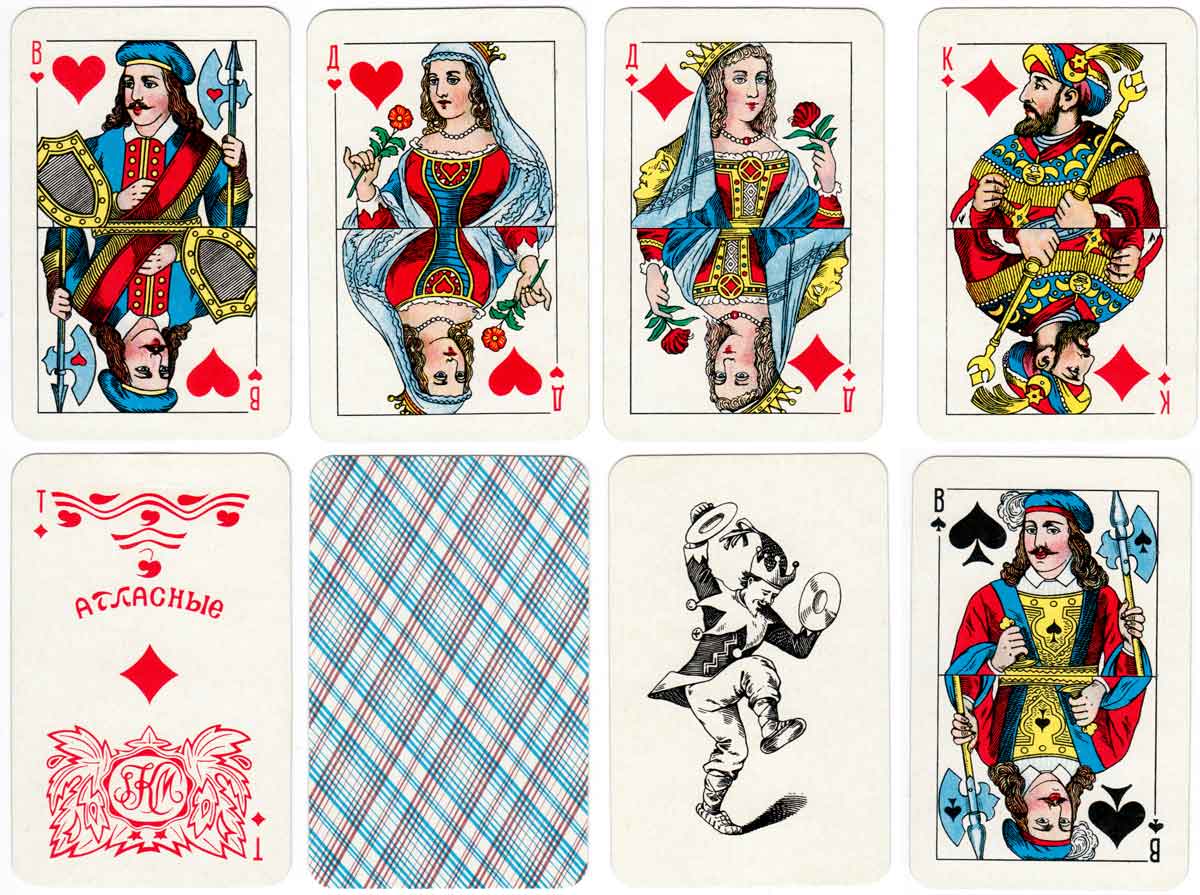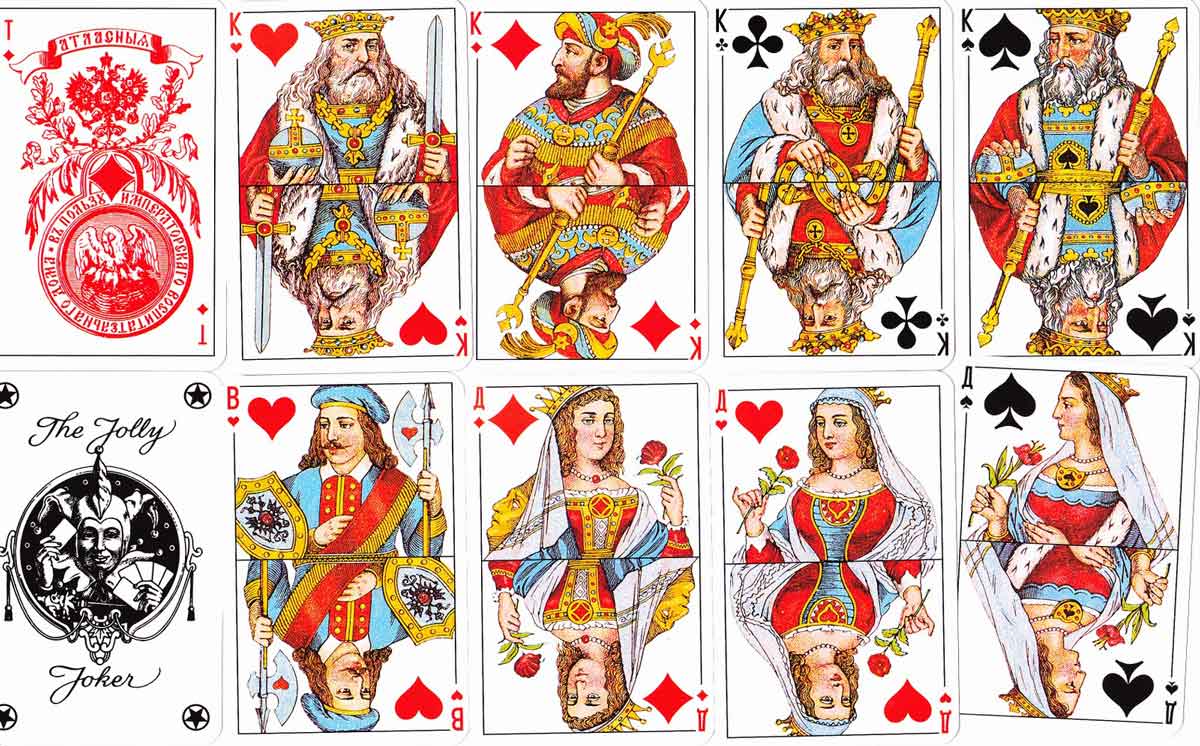Epokha vozrozhdeniya (Age of Enlightenment)
Epokha vozrozhdeniya (Age of Enlightenment): this pack has effectively become the Russian standard.
This pack was designed by Adolf Iosifovich Charlemagne (1826-1901) but it is essentially a remake of the cards which were still used by the Russian card factories to produce the most mass-marketed cards in the 18th and the beginning of the 19th century (see here). This pack has also come to be known as “Atlas” (a name assigned to the cards with Charlemagne’s design). These playing cards were and are still the most popular ones throughout Russia, and have become de facto the standard Russian pack.
The name “Atlas” itself didn’t refer to any sketches or a particular card style, but to the technology of manufacturing. To make cards look better the paper they were printed on was firstly rubbed with talc powder with the help of special talc machines. Made on this type of paper, these cards were not affected by water, slid freely while shuffled, but were more expensive.

Above: cards from a Russian standard pack. Image courtesy Rex Pitts.


By Rex Pitts (1940-2021)
Member since January 30, 2009
Rex's main interest was in card games, because, he said, they were cheap and easy to get hold of in his early days of collecting. He is well known for his extensive knowledge of Pepys games and his book is on the bookshelves of many.
His other interest was non-standard playing cards. He also had collections of sheet music, music CDs, models of London buses, London Transport timetables and maps and other objects that intrigued him.
Rex had a chequered career at school. He was expelled twice, on one occasion for smoking! Despite this he trained as a radio engineer and worked for the BBC in the World Service.
Later he moved into sales and worked for a firm that made all kinds of packaging, a job he enjoyed until his retirement. He became an expert on boxes and would always investigate those that held his cards. He could always recognize a box made for Pepys, which were the same as those of Alf Cooke’s Universal Playing Card Company, who printed the card games. This interest changed into an ability to make and mend boxes, which he did with great dexterity. He loved this kind of handicraft work.
His dexterity of hand and eye soon led to his making card games of his own design. He spent hours and hours carefully cutting them out and colouring them by hand.
Related Articles

Luditz Pattern by Georg Geiselreiter
The discovery of 2024 changes the current state of knowledge of the history of this pattern.

Czech National Patterns by S.D. Modiano
Modiano produced cards with the Prague and Trappola patterns in the early 20th century.

Doppel-Deutsche Karten by Bratří Willnerové, Teplice
This deck from local manufacturer Bratří Willnerová offers a standard version of the popular Central...

Prager Pattern by Bratří Willnerové, Teplice
Traditional single-ended Prager pattern by Willner Brothers from northern Bohemia.

International pattern from Russia
Colourful international pattern cards from Russia sold in Latvia.

Egyptium
“Egyptium” is a hand-illustrated deck of fantasy playing cards with artwork by Russian artist Oleg S...

Russian Circus deck
The Russian Circus deck published by the Imperial Playing Card Factory, St Petersburg.

English Pattern by B.P. Grimaud
Standard English pattern published by B.P. Grimaud with engraving by F. Simon, c.1880.

English cards from the reign of Charles II
This article explores a historic pack of English playing cards from circa 1675, likely used by King ...

Why our playing-cards look the way they do
Analysis of early playing card designs: origins, suit differences, standardization, technological ad...

Introduction to Collecting Themes
Playing cards can be broadly categorised into standard and non-standard designs, with collectors app...

Wedding of Krechinsky • Свадьба Кречинского
A pack of cards depicting characters from the famous play "The Wedding of Krechinsky" by Sukhovo-Kob...

Russian folk art playing cards
Russian folk art playing cards produced by Natalia Silva, USA, 2017.

Branle playing cards
‘Branle’ playing cards inspired by a 12th-century dance, produced by Noir Arts, USA, 2015.

Early German playing cards
Some early examples of popular German playing cards from the XV and XVI centuries.

Theatre of Pain / Teatr Boli
Theatre of Pain / Teatr boli playing cards depicting politicians and leaders in the Caucasus territo...
Most Popular
Our top articles from the past 28 days

